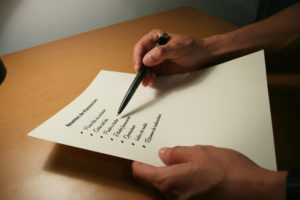 If you read for work, it’s likely you encounter bad writing.
If you read for work, it’s likely you encounter bad writing.
Just think about all the email messages, memos, documents and other business writing that you read during the course of a day.
Rather than read at a steady pace, you probably hit many speed bumps along the way that cause you to slow or even stop.
These bumps in the road can include awkward phrasing, abbreviations you don’t know, circular thinking, or any number of problems. When you reach the end, you can be more confused than when you started.
According to technology analyst and professional writer Josh Bernoff, the extra time you and others spend slogging through bad writing costs the U.S. economy almost $400 billion a year.
In my blog post How to start solving our $396 billion bad writing problem, I shared three actions to take to improve your writing so you wouldn’t be a prime offender.
I also asked my newsletter readers what they are doing to address this huge problem of bad writing. Several graciously responded. Thank you!
Their helpful suggestions include:
- For email messages, use a brief and accurate subject line. And be willing to adjust that line after several volleys of messages to fit the current situation. “So many times folks in my organization have missed important updates because the subject in the body of the email string changed, but the subject line didn’t,” one individual observed.
- Proofread after you use spell check. “Read twice, send once” is a good rule of thumb for email messages. Spell check won’t catch missing words or “wordos,” the correct spelling of a real word that’s used incorrectly in the context.
- Read your message or document out loud. If the document is important, print it and read it, preferably out loud. (Yes, with your printed pages, you won’t be as green as you’d like. But you won’t be contributing to information pollution, which is how some view the wastefulness of bad writing.) You can sometimes HEAR errors that you cannot see. Or, if you run out of breath you may have a run-on sentence that needs shortening or to be turned into two or more sentences.
- Avoid using abbreviations or acronyms. Even though you may think the abbreviation or acronym is well known, individuals who don’t know what you’re referring to have to spend even more time figuring out what you’re trying to say. Also, they may feel excluded or marginalized.
- Watch out for pronouns. All too often pronouns are ambiguous and confusing. Who is the “he” or “she” referring to? Instead, use the actual noun or name even though you’re concerned that the repetition is redundant. At least, you’re being clear and avoiding any misinterpretation.
- Put aside your message and reread it an hour or two later, or even the next day, to tighten it up. When you look at your message with fresh eyes, you often can find chunks that you can delete. Or, you can ask someone else to read it for you. An extra set of eyes is always helpful.
- If you are asking someone to do something, make sure your “call to action” is easy to find, clear and simple to do. Otherwise, they won’t even see it, or know what to do. Bad calls to actions are another form of information pollution. For more on this topic, check out Stop polluting; avoid bad asks.
The 10 solutions from this post and the original won’t solve our almost $400 billion a year bad writing problem.
However, if you and others practice these tips regularly, you will make a dent and start to improve your writing. And you’ll earn more respect and credibility as a good communicator who doesn’t pollute.
Any other ideas out there? If so, please share.

0 Comments